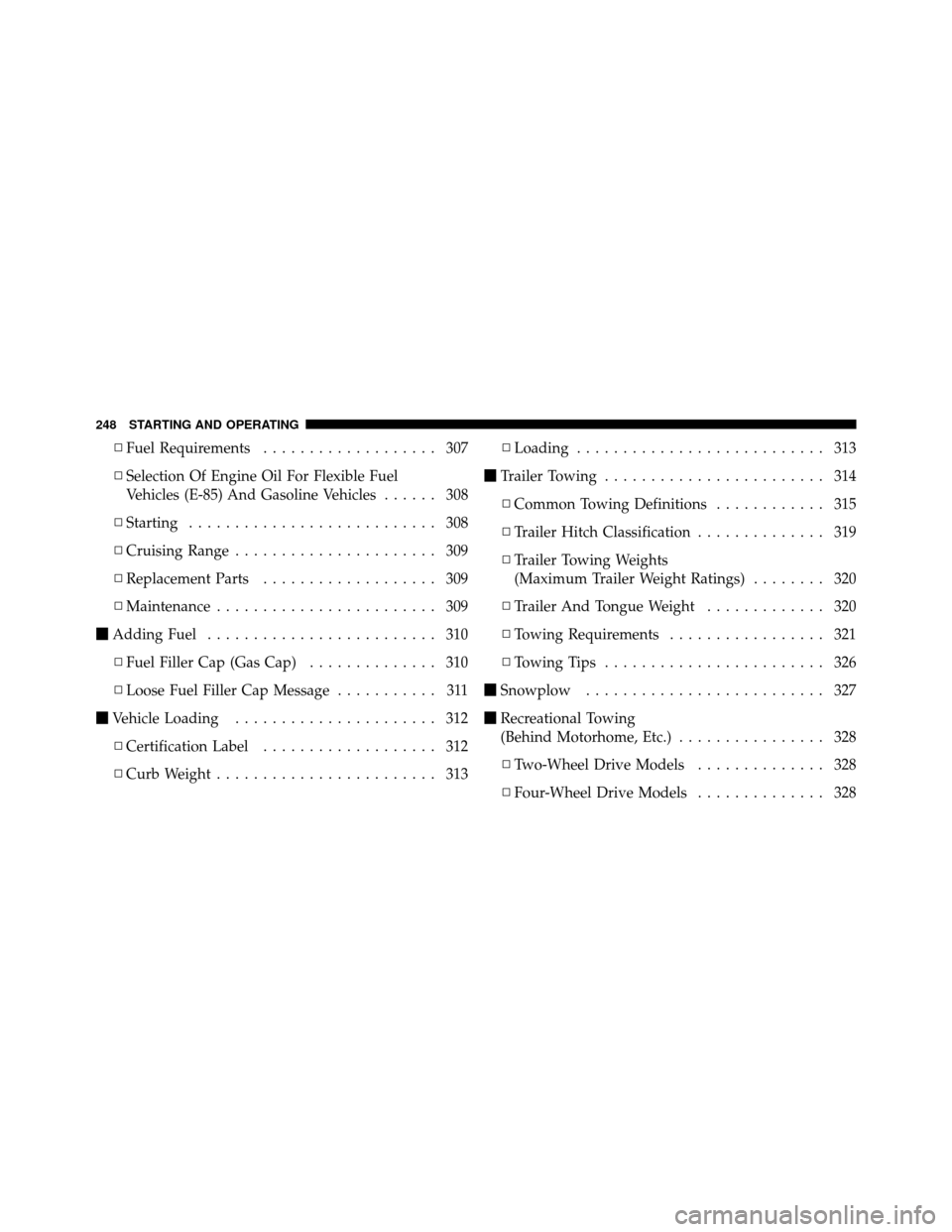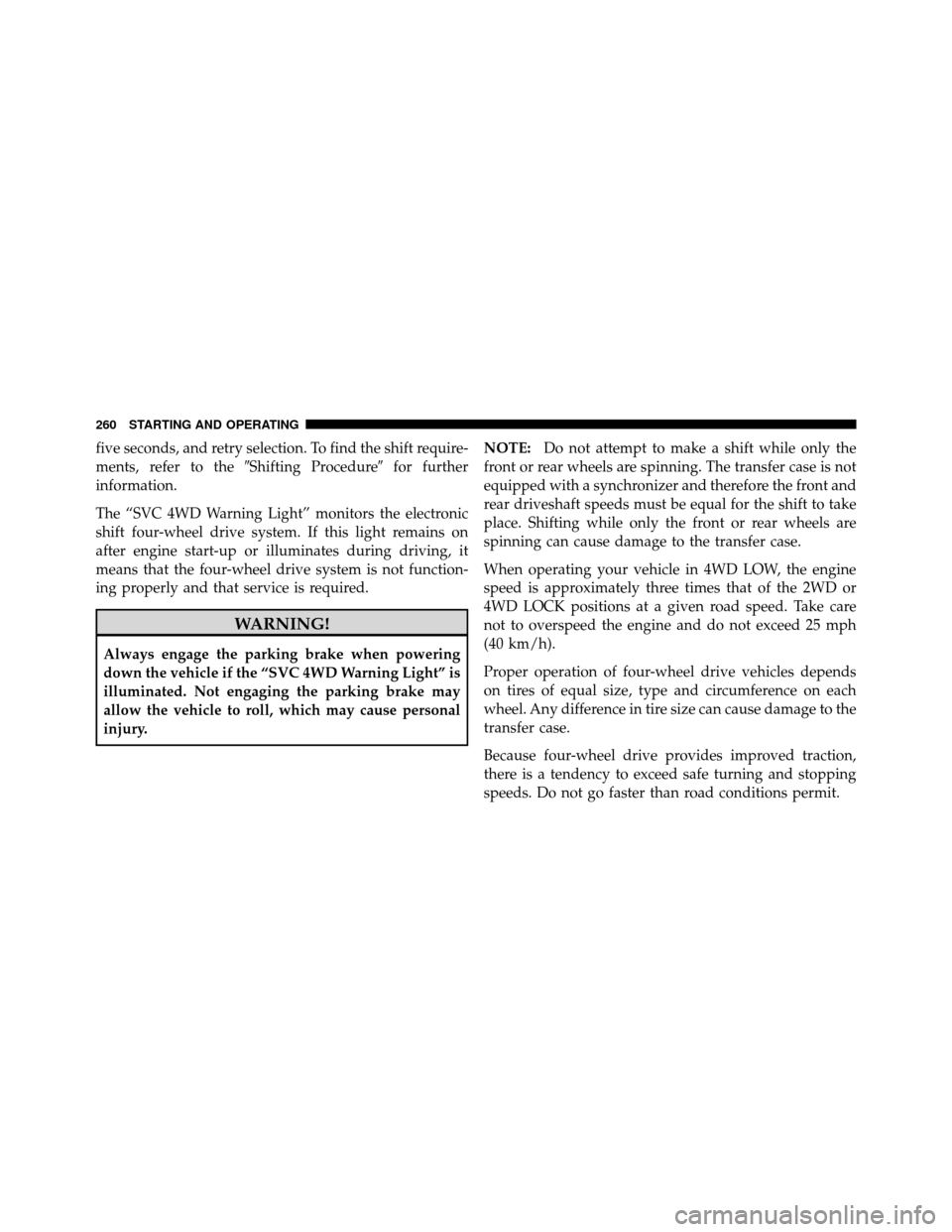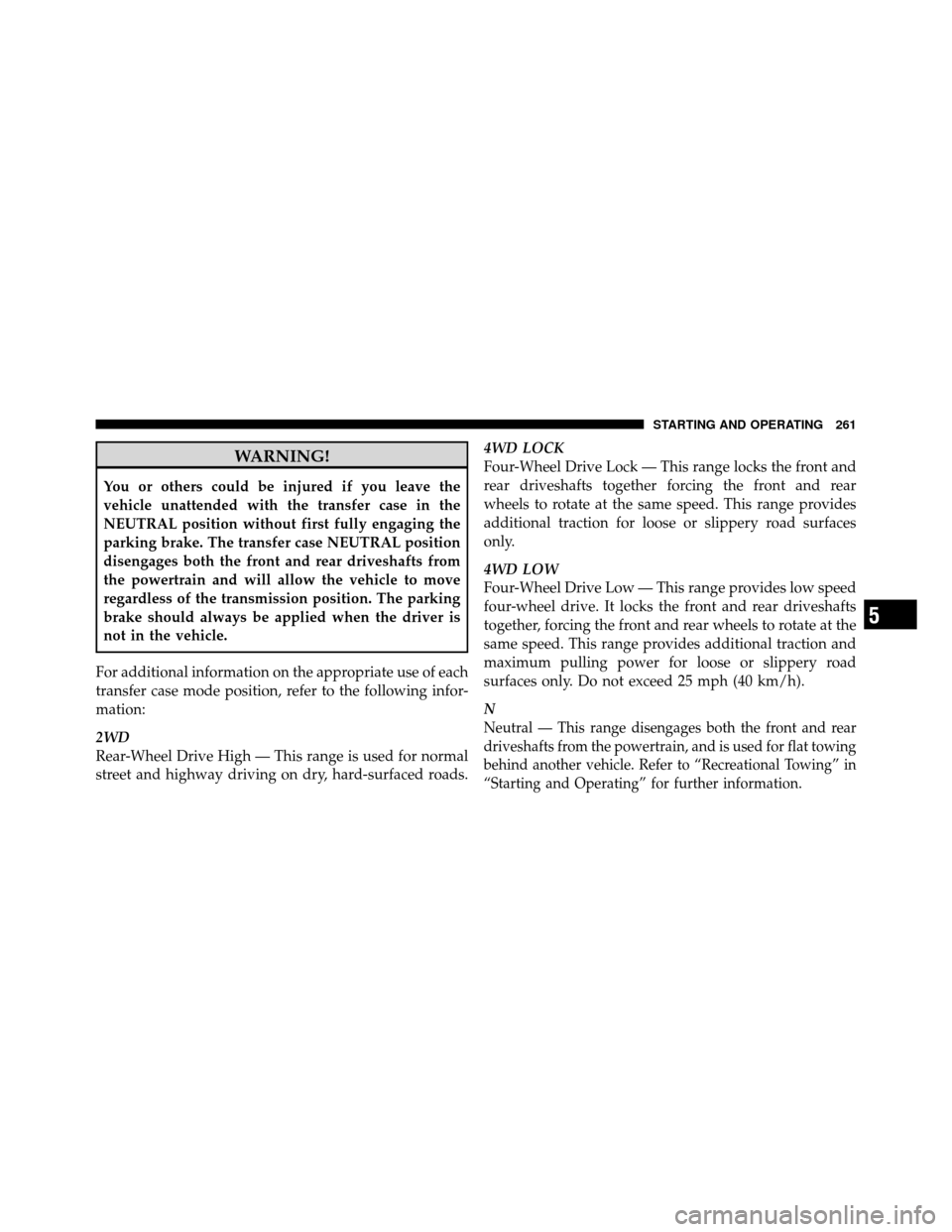Page 247 of 452
STARTING AND OPERATING
CONTENTS
�Starting Procedures .................... 249
▫ Automatic Transmission ............... 249
▫ Normal Starting ..................... 249
▫ Extreme Cold Weather
(Below –20°F Or –29°C) ................ 250
▫ If Engine Fails To Start ................ 250
▫ After Starting ....................... 251
� Engine Block Heater — If Equipped ........ 251�
Automatic Transmission ................. 252
▫ Key Ignition Park Interlock ............. 253
▫ Brake/Transmission Interlock System ...... 253
▫ Automatic Transmission ............... 253
▫ Gear Ranges ........................ 253
� Four-Wheel Drive Operation — If Equipped . . 258
▫ Transfer Case Operating Information/
Precautions ......................... 258
▫ Shifting Procedure ................... 262
5
Page 248 of 452

�Limited-Slip Rear Axle Differential — If
Equipped ............................ 264
� Driving On Slippery Surfaces ............. 264
▫ Acceleration ........................ 264
▫ Traction ........................... 265
� Driving Through Water ................. 265
▫ Flowing/Rising Water ................. 266
▫ Shallow Standing Water ............... 266
� Off-Road Driving Tips .................. 268
▫ After Driving Off-Road ................ 268
� Power Steering ....................... 269
▫ Power Steering Fluid Check ............. 270
� Parking Brake ........................ 271 �
Brake System ........................ 273
▫ Four-Wheel Anti-Lock Brake System (ABS) . . 273
� Tire Safety Information ................. 275
▫ Tire Markings ....................... 275
▫ Tire Identification Number (TIN) ......... 278
▫ Tire Terminology And Definitions ......... 279
▫ Tire Loading And Tire Pressure .......... 280
� Tires — General Information ............. 284
▫ Tire Pressure ....................... 284
▫ Tire Inflation Pressures ................ 285
▫ Tire Pressures For High Speed Operation . . . 286
▫ Radial Ply Tires ..................... 287
246 STARTING AND OPERATING
Page 249 of 452

▫Spare Tire Matching Original Equipped Tire
And Wheel – If Equipped .............. 287
▫ Compact Spare Tire – If Equipped ........ 288
▫ Full Size Spare – If Equipped ............ 289
▫ Limited-Use Spare – If Equipped ......... 289
▫ Tire Spinning ....................... 290
▫ Tread Wear Indicators ................. 290
▫ Life Of Tire ........................ 291
▫ Replacement Tires .................... 292
� Tire Chains .......................... 293
� Snow Tires .......................... 295
� Tire Rotation Recommendations ........... 295
� Tire Pressure Monitor System (TPMS) ....... 296
▫ Base System ........................ 299 ▫
General Information .................. 301
� Fuel Requirements ..................... 301
▫ Reformulated Gasoline ................ 302
▫ Gasoline/Oxygenate Blends ............. 302
▫ E-85 Usage In Non-Flex Fuel Vehicles ...... 303
▫ MMT In Gasoline .................... 303
▫ Materials Added To Fuel ............... 304
▫ Fuel System Cautions ................. 304
▫ Carbon Monoxide Warnings ............ 305
� Flexible Fuel (4.7L Engine Only) —
If Equipped .......................... 306
▫ E-85 General Information ............... 306
▫ Ethanol Fuel (E-85) ................... 307
5
STARTING AND OPERATING 247
Page 250 of 452

▫Fuel Requirements ................... 307
▫ Selection Of Engine Oil For Flexible Fuel
Vehicles (E-85) And Gasoline Vehicles ...... 308
▫ Starting ........................... 308
▫ Cruising Range ...................... 309
▫ Replacement Parts ................... 309
▫ Maintenance ........................ 309
� Adding Fuel ......................... 310
▫ Fuel Filler Cap (Gas Cap) .............. 310
▫ Loose Fuel Filler Cap Message ........... 311
� Vehicle Loading ...................... 312
▫ Certification Label ................... 312
▫ Curb Weight ........................ 313 ▫
Loading ........................... 313
� Trailer Towing ........................ 314
▫ Common Towing Definitions ............ 315
▫ Trailer Hitch Classification .............. 319
▫ Trailer Towing Weights
(Maximum Trailer Weight Ratings) ........ 320
▫ Trailer And Tongue Weight ............. 320
▫ Towing Requirements ................. 321
▫ Towing Tips ........................ 326
� Snowplow .......................... 327
� Recreational Towing
(Behind Motorhome, Etc.) ................ 328
▫ Two-Wheel Drive Models .............. 328
▫ Four-Wheel Drive Models .............. 328
248 STARTING AND OPERATING
Page 260 of 452
transmission is sufficiently warm, will demonstrate
that the transmission is able to shift into, and out of
Overdrive.
•If the vehicle has not been driven in several days, the
first few seconds of operation after shifting the trans-
mission into gear may seem sluggish. This is due to the
fluid partially draining from the torque converter into
the transmission. This condition is normal and will not
cause damage to the transmission. The torque con-
verter will refill within five seconds of shifting from
PARK into any other gear position.
FOUR-WHEEL DRIVE OPERATION —
IF EQUIPPED
Transfer Case Operating Information/Precautions
The electronic-shift transfer case is operated by the
transfer case switch, which is located on the instrument
panel.The transfer case provides four mode positions:
•Two-wheel drive high range (2WD)
•Four-wheel drive lock range (4WD LOCK)
•Four-wheel drive low range (4WD LOW)
•Neutral (N)
Transfer Case Switch
258 STARTING AND OPERATING
Page 261 of 452

The transfer case is designed to be driven in the two-
wheel drive position (2WD) for normal street and high-
way conditions on dry hard-surfaced roads.
When additional traction is required, the transfer case
4WD LOCK and 4WD LOW positions can be used to lock
the front and rear driveshafts together and force the front
and rear wheels to rotate at the same speed. This is
accomplished by turning the transfer case switch to the
desired position - Refer to “Shifting Procedure” for
further information. The 4WD LOCK and 4WD LOW
positions are designed for loose or slippery road surfaces
only. Driving in the 4WD LOCK and 4WD LOW posi-
tions on dry hard-surfaced roads may cause increased
tire wear and damage to the driveline components.
NOTE:The transfer case NEUTRAL position is selected
by pressing the recessed button located on the lower
left-hand corner of the transfer case switch. The transfer case NEUTRAL position is to be used for recreational
towing only. Refer to “Recreational Towing” in “Starting
and Operating” for further information.
Transfer Case Position Indicator Lights
The Transfer Case Position Indicator Lights (4WD and
4LOW) are located on the instrument cluster. If there is
no indicator light on or flashing, the transfer case is in
two-wheel drive (2WD). If the indicator light is on, the
desired position (4WD LOCK and 4WD LOW) has been
obtained.
If one or more shift requirements are not met:
1. An indicator light will flash.
2. The transfer case
will notshift.
NOTE: Before retrying a selection, make certain that all
the necessary requirements for selecting a new transfer
case position have been met. To retry the selection, turn
the transfer case switch back to the current position, wait
5
STARTING AND OPERATING 259
Page 262 of 452

five seconds, and retry selection. To find the shift require-
ments, refer to the�Shifting Procedure�for further
information.
The “SVC 4WD Warning Light” monitors the electronic
shift four-wheel drive system. If this light remains on
after engine start-up or illuminates during driving, it
means that the four-wheel drive system is not function-
ing properly and that service is required.
WARNING!
Always engage the parking brake when powering
down the vehicle if the “SVC 4WD Warning Light” is
illuminated. Not engaging the parking brake may
allow the vehicle to roll, which may cause personal
injury. NOTE:
Do not attempt to make a shift while only the
front or rear wheels are spinning. The transfer case is not
equipped with a synchronizer and therefore the front and
rear driveshaft speeds must be equal for the shift to take
place. Shifting while only the front or rear wheels are
spinning can cause damage to the transfer case.
When operating your vehicle in 4WD LOW, the engine
speed is approximately three times that of the 2WD or
4WD LOCK positions at a given road speed. Take care
not to overspeed the engine and do not exceed 25 mph
(40 km/h).
Proper operation of four-wheel drive vehicles depends
on tires of equal size, type and circumference on each
wheel. Any difference in tire size can cause damage to the
transfer case.
Because four-wheel drive provides improved traction,
there is a tendency to exceed safe turning and stopping
speeds. Do not go faster than road conditions permit.
260 STARTING AND OPERATING
Page 263 of 452

WARNING!
You or others could be injured if you leave the
vehicle unattended with the transfer case in the
NEUTRAL position without first fully engaging the
parking brake. The transfer case NEUTRAL position
disengages both the front and rear driveshafts from
the powertrain and will allow the vehicle to move
regardless of the transmission position. The parking
brake should always be applied when the driver is
not in the vehicle.
For additional information on the appropriate use of each
transfer case mode position, refer to the following infor-
mation:
2WD
Rear-Wheel Drive High — This range is used for normal
street and highway driving on dry, hard-surfaced roads. 4WD LOCK
Four-Wheel Drive Lock — This range locks the front and
rear driveshafts together forcing the front and rear
wheels to rotate at the same speed. This range provides
additional traction for loose or slippery road surfaces
only.
4WD LOW
Four-Wheel Drive Low — This range provides low speed
four-wheel drive. It locks the front and rear driveshafts
together, forcing the front and rear wheels to rotate at the
same speed. This range provides additional traction and
maximum pulling power for loose or slippery road
surfaces only. Do not exceed 25 mph (40 km/h).
N
Neutral — This range disengages both the front and rear
driveshafts from the powertrain, and is used for flat towing
behind another vehicle. Refer to “Recreational Towing” in
“Starting and Operating” for further information.
5
STARTING AND OPERATING 261